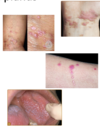Derm misc- in class lecture Flashcards
(60 cards)
Which derm condition?

- Non-scarring focalized hair loss
- Higher incidence in younger ages
- autoimmune attack on the hair follicles by autoreactive CD8 T-cells
Alopecia areata
Clinical presentation of which derm condition?
- Abrupt onset
- well-demarcated bald spots on scalp/other parts of body
- _*Exclamation point hairs*_

Alopecia areata
How do you tx Alopecia areata?
- Spontaneous remission in ~6mo often occurs
- Topical corticosteroids (superpotent- under occlusion, or potent- combo w/ minoxidil)
- Topical Minoxidil
- Intralesional corticosteroids (1st line in adults)
What is the first line tx of Alopecia areata in adults
Intralesional corticosteroids
How do you manage Alopecia areata?
- Psychological support, support groups
- Refer to derm if involvement of larger areas
Which derm condition?
- Inflammation of the lateral or proximal nail folds
- MC etiology- S. aureus
- Risk factors: nail biting, picking at hang nails, DM, occupational risks

Paronychia
How do you tx a parnoychia WITHOUT an abscess?
- Warm compresses/soaks
- topical abx
- more severe cases- oral Cephalexin or dicloxacillin
How do you tx a parnoychia WITH an abscess?
I&D
Which derm condition?
- Hypermelanosis at sun-exposed areas of face
- Common in pregnancy or people taking OCPs
Melasma
Clinical presentation of which derm condition?
- Brownish macules w/ irregular borders
- Symmetric
- On face
- Sun exposure intensifies lesions

Melasma
How do you tx melasma?
- Sun protection and avoidance
- Hypopigmenting agents (hydroquinone, azelaic acid, tretinoin, etc)
T/F: Melasma is chronic and recurrence is common
True
Better prognosis if pregnancy related
Which derm condition?
- Progressive, autoimmune destruction of melanocytes leading to depigmentation

Vitiligo
Which derm condition?
- Chronic inflammatory dermatosis related to chronic venous insufficiency
- Predisposing factors- vericose veins, prolonged standing, etc

Stasis dermatitis
How do you dx and tx Stasis dermatitis?
- Dx: clinical, ultrasound
- Tx:
- Direct tx towards venous insufficiency (leg elevation, continuous compression therapy, etc)
- appropriate skin care and dressings
- topical corticosteroids if pruritic
- prevention/tx of ulcers
Which derm condition?
- Localized, lichenification from repetitive rubbing/scratching
- Highest prevalence: women, >20 years old, atopic individuals
Lichen Simplex chronicus
The following is the clinical presentation of which derm condition?
- Well-defined plaques made by confluent papules,
- Thickened skin - dull red color that can progress to brown or black
- Excoriations

Liche Simplex Chronicus
What are the 2 treatments for Lichen Simplex Chronicus?
1. Stop scratchig/rubbing
- Topical Corticosteroids
Which derm condition?
- MC 30-60y/o
- 4Ps- Purple (violaceous), Polygonal, pruritic, papules/plaques
- Koebner phenomenon (skin lesions along lines of trauma)
- Wickman’s striae- fine white lines form network over papules

Lichen Planus
What is the 1st line treatment for Lichen Planus?
1st line= Topical, intralesional, or oral corticosteroids (if severe)
Can also tx w/ retinoids, photochemotherapy and cyclosporine
What are the 4 stages of pressure ulcers?
4 stages- ulcers classified by depth of soft tissue damage:

- I: non-blancheable erythema of intact skin
- II: partial-thickness skin loss involving epidermis, dermis, or both
- III: full-thickness skin loss involving damage to or necrosis of subcutaneous tissue that may extend to the underlying fascia (but not through)
- IV: full-thickness skin loss with extensive necrosis of or damage to muscle, bone, or supporting structures
What are the 3 complications of pressure ulcers?
- Complications:
- local infection
- osteomyolitis
- sepsis
Which derm condition?
- Chronic inflammatory disorder involving hair follicle
- MC area: intertrignous areas
- Women 18-29y/o
- Contributing factors: obesity, smoking, hormones, etc (also assoc. w/ DM/PCOS)
Hidradenitis suppurativa
Which derm condition?
- Recurrent inflammed nodules
- Draining sinus tracts
- comedones
- scarring
Hidradenitis suppurativa












